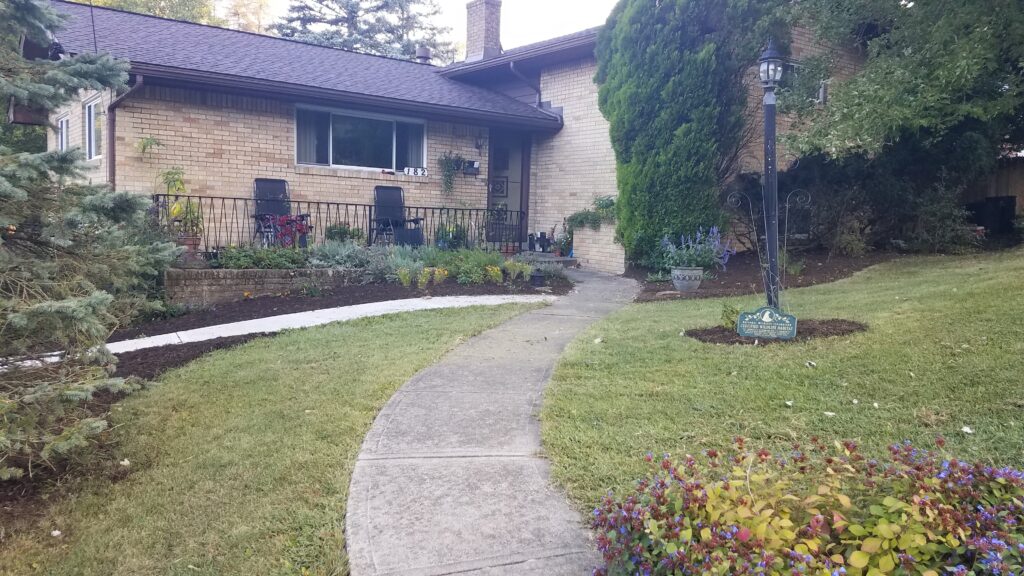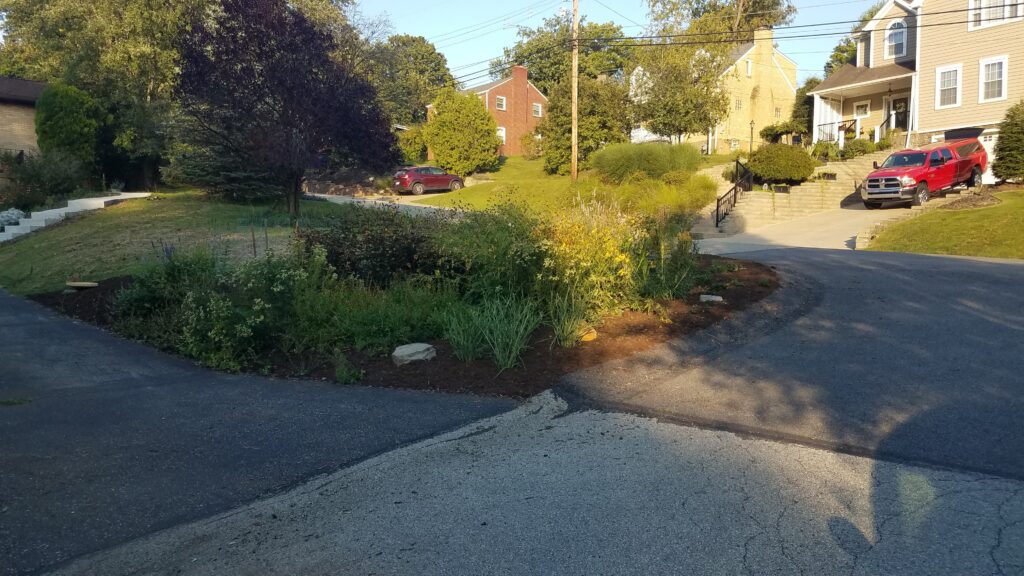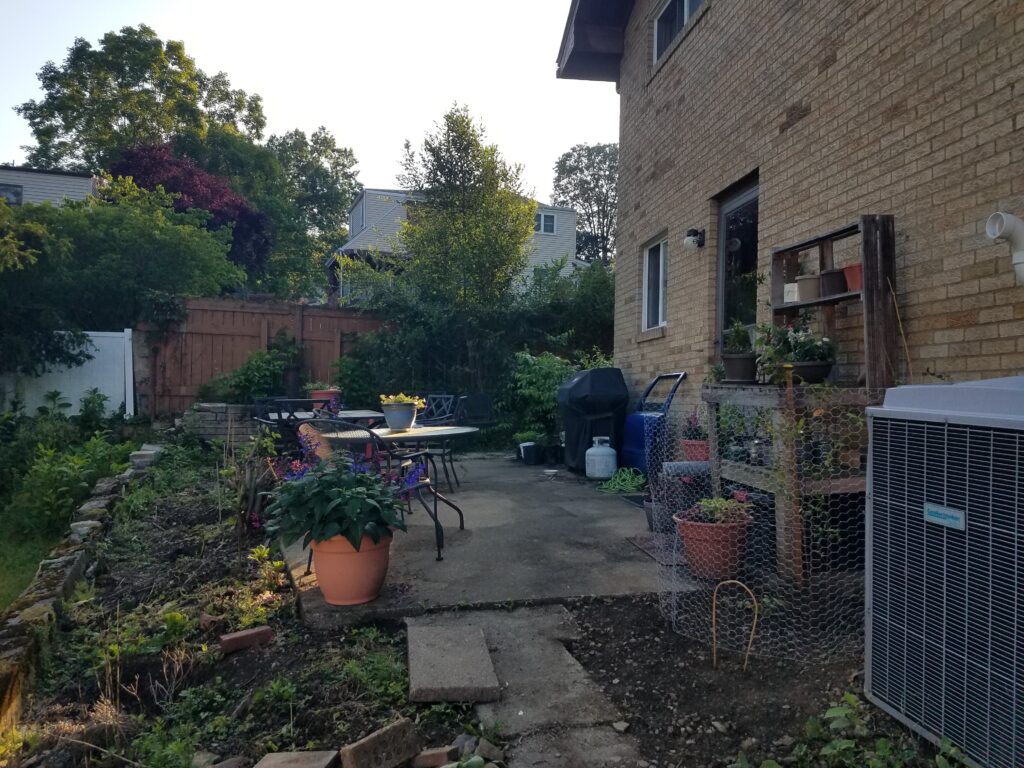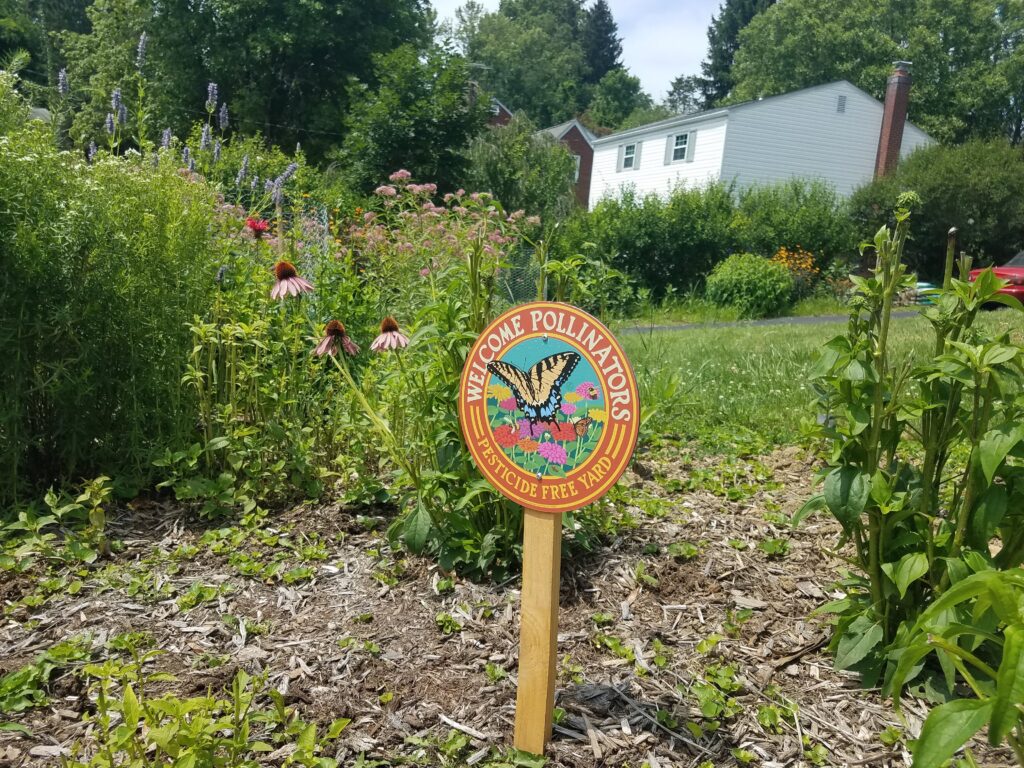I try to spend time outside on each solstice and equinox, and when Fall came in at 2:49 AM on Saturday morning, September 23, I likely will have been sleeping in a tent in the mountains of West Virginia, with my phone turned off and nestled at the bottom of my backpack. Indeed, I have spent a lot of time outside this year – probably more than I expected – while continuing to work toward creating a native pollinator paradise of my yard.
Now in its sixth year, my expansive, multi-year garden project has bloated to massive proportions – I believe we are now approaching 2,000 square feet of garden space. While I love every minute of it, it is a lot of work, especially because I unwittingly made things much harder for myself through poor decisions last fall and this spring. Nevertheless, I am seeing slow but steady progress, and I am excited to share that progress in this year’s garden update.
Garden Certification
At the end of May, I celebrated my birthday with my family and received some incredible garden-related presents, including a gift certificate to a native plant nursery south of Pittsburgh, [1] a gift certificate to my aunt’s nursery back east, [2] and an official certification by the National Wildlife Federation: my yard is now listed as an official wildlife habitat.

My mom, sneaky woman that she is, surreptitiously asked me questions about my garden over time and then registered my yard on the National Wildlife Federation website. She even listened with mock amazement as I read her my Audubon certification blog post [4] (before giving me my present), having already gone through the NWF certification process for my yard. The checklist of elements required for certification include: [5]
- Three types of food sources (such as native plants, feeders, or leaving leaves where they fall)
- One type of water source (such as a birdbath, stream, or rain garden)
- Two places for shelter from weather and predators (such as wooded areas, brush piles, rock piles, or leaving dead perennial stems to overwinter)
- Two places to raise young (such as mature trees, nesting boxes, or dense shrubs)
- And two out of three sustainable practices (including soil and water conservation, controlling exotic species, and organic gardening practices)
As part of the process, you can order a sign for your yard, which my mom also did. I have placed it prominently near our front walk, and several neighbors have commented on it thus far. I have met one new neighbor whose yard is also certified, and a few others have asked about what the process entails. While I would be adhering to these best practices regardless of my certification status, I love how it has become a teaching opportunity and conversation starter.
Corn Gluten Meal
Part of the reason I’ve had a chance to talk with so many neighbors as they walk past is because I myself have been spending what seems like significantly more time in the yard this year. And even if it’s not more time, it has been far less time planting and far more time weeding. A few years ago in my annual garden update I described the use of corn gluten meal as a pre-emergent weed killer. [6] Spreading it at specific times in spring and fall (and following the directions to the letter) helps prevent weeds from sprouting and taking root. To be entirely honest, I wasn’t sure how much good it was doing. I skipped it during what was a busy fall last year and again during what was an inordinately busy spring this year.

There’s a saying that goes “if you think no one cares about you, try not paying your bills.” That came to mind several times this summer as I spent hours upon hours weeding the yard: if you think corn gluten doesn’t work, try not using it. So many of my plants spread like wildfire through the garden, with volunteer sage, heliopsis, and milkweed popping up where I didn’t expect them. I left some in place, but I think it was mostly because I simply didn’t have the time to pull everything that wasn’t where it was “supposed to be.”
Ultimately, I do want my garden to look wild – and it is starting to in certain places this year, which makes me very happy. I don’t want one thing to take over, though, which could happen while I’m stuck in analysis paralysis. It is my hope that as I figure out what plants work best in combination, I can keep the more established ones at bay and give the newer ones a chance to fill in. That said, I am also aware that the more filled-in my garden becomes, the less chance the weeds will have to take over entirely.
New Additions
Unfortunately, I didn’t see any caterpillars this year, and I’m not sure why. It made me sad to watch my butterfly weed go begging, especially after it was so popular last year [7] … and because the whole idea behind this garden was to support monarch butterflies. Part of me wonders if the butterfly weed was so drowned out in other weeds that the monarchs couldn’t even find it.

And the weeds – particularly the grasses – seemed to be more intense than last year. All year, once I made it from one end of the garden to the other, I had to go back and start over at the beginning, which was already getting overtaken with weeds. Because I was spending all of my time taking weeds out of the ground, I barely got a chance to put any new plans in the ground. All that said, I was happy to add the following native perennials to my garden:
- Black-eyed Susans (I’ve got several types now – this summer brought another one) – Reudbeckia fulgida var fulgida [9]
- Blue flag iris – Iris versicolor [10]
- Blue-eyed grass – Sisyrinchium angustifolium [11]
- Cardinal flower – Lobelia cardinalis [12]
- Coral honeysuckle – Lonicera sempervirens [13]
- Nodding onion – Allium cernuum [14]
- Sneezeweed – Helenium amarum [15]
- Wine cups – Callirhoe involucrata [16]
- Woodland stonecrop – Sedum ternatum [17]
And the following native shrubs:
- Arrowwood viburnum – Viburnum dentatum [18]
- Northern bayberry – Morella pensylvanica [19]
- Northern spicebush – Lindera benzoin [20]
- Red twig dogwood – Cornus sericea [21]
- Virginia sweetspire – Itea virginica [22]
From my aunt’s garden center, I got a bunch of beautiful annuals that made up an expanded container garden. Some of those pots wound up filling gaps my existing garden space in the front yard and bringing much-needed color to the back patio while I cleared the fence and the weeds. And although they’re not native, I am still planning to plant some bulbs this fall – daffodils for me and tulips for Christian.

We are now into September (and Fall by the time this post is live), and we’ve had a couple cold days so far. You’d better believe my corn gluten meal is already spread and watered at this point, in order to save me some weeding effort next year. While I’m close to being done with my 2023 gardening, I’m looking forward to spending a little more time outside while I can this season and continuing to fill out my expanded garden beds next year.
~
Did you plant any natives this year? Are you planning a native garden? I’d love to hear about what you’re working on below.
Thanks for reading!
Keep reading about this year’s garden updates –>
[1] https://arcadianatives.com/
[2] https://www.facebook.com/pharogardencentre/
[3] https://radicalmoderate.online/concrete/
[4] https://radicalmoderate.online/for-the-birds/
[5] https://www.nwf.org/certifiedwildlifehabitat
[6] https://radicalmoderate.online/eco-friendly-weed-control-2020-update/
[7] https://radicalmoderate.online/milkweed-monarchs/
[8] https://radicalmoderate.online/spicebush-planting-a-native-hedge/
[9] https://www.wildflower.org/plants/result.php?id_plant=RUFUF
[10] https://www.wildflower.org/plants/result.php?id_plant=irve2
[11] https://www.wildflower.org/plants/result.php?id_plant=sian3
[12] https://www.wildflower.org/plants/result.php?id_plant=LOCA2
[13] https://www.wildflower.org/plants/result.php?id_plant=LOSE
[14] https://www.wildflower.org/plants/result.php?id_plant=ALCE2
[15] https://www.wildflower.org/plants/result.php?id_plant=HEAM
[16] https://www.wildflower.org/plants/result.php?id_plant=CAIN2
[17] https://www.wildflower.org/plants/result.php?id_plant=SETE3
[18] https://www.wildflower.org/plants/result.php?id_plant=VIDE
[19] https://www.wildflower.org/plants/result.php?id_plant=MOPE6
[20] https://www.wildflower.org/plants/result.php?id_plant=LIBE3
[21] https://www.wildflower.org/plants/result.php?id_plant=COSE16
[22] https://www.wildflower.org/plants/result.php?id_plant=ITVI
0 Comments